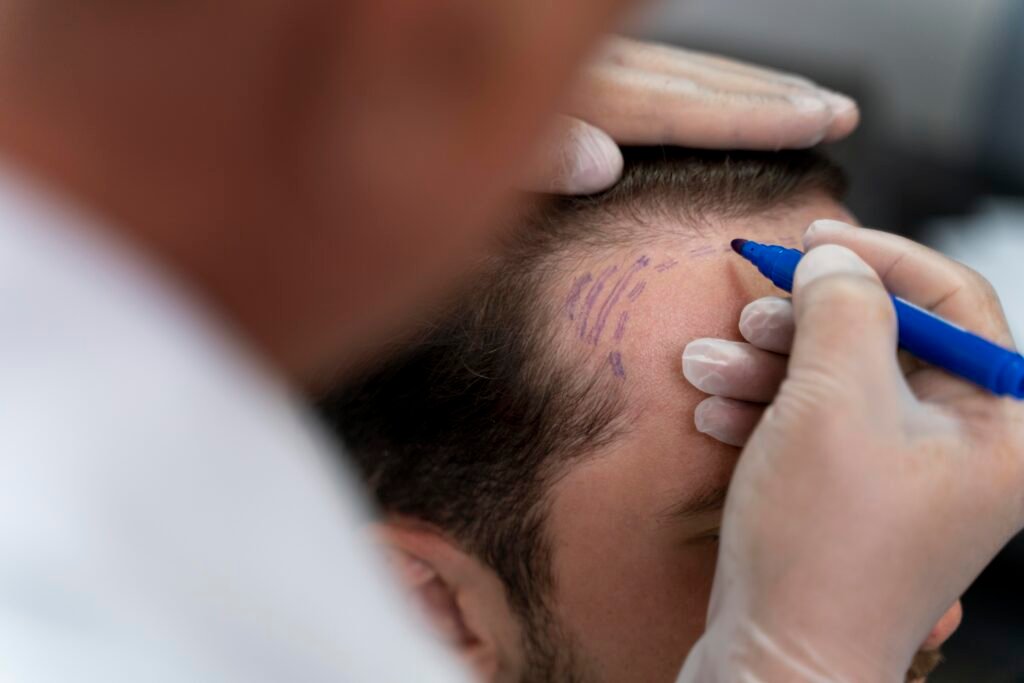Hair loss can be a distressing experience for many individuals, but modern advancements in hair restoration have provided promising solutions. Two of the most effective treatments for hair restoration are Hair Transplant and Platelet-Rich Plasma (PRP) Therapy. Below is a detailed explanation of both procedures, their benefits, and answers to common questions.
Hair Transplant
Hair transplant is a surgical procedure where hair follicles are taken from a donor area (usually the back of the head) and transplanted to areas with thinning or no hair.
- Procedure: The surgeon will typically use one of two methods:
- FUE (Follicular Unit Extraction): Individual hair follicles are removed from the donor area and transplanted into the recipient area.
- FUT (Follicular Unit Transplantation): A strip of skin is removed from the donor area, and hair follicles are harvested from it.
- Results: Transplanted hair typically grows naturally, and the results are permanent, providing a natural look once fully healed.
- Recovery: Post-procedure care is important. Most patients can return to work within a few days, but strenuous activities should be avoided for a few weeks.
- Success Rate: When performed by an experienced surgeon, hair transplant has a high success rate, and most patients see visible results within 6-12 months.
Benefits of Hair Transplant
- Permanent solution for hair loss.
- Natural-looking results.
- Minimal scarring, especially with FUE.
- Little maintenance required after the healing process.
PRP (Platelet-Rich Plasma) Therapy
PRP therapy is a non-surgical treatment that uses your body’s own platelets to stimulate hair growth. It’s often used as a complementary treatment to enhance the results of a hair transplant or to treat early stages of hair loss.
- Procedure: A blood sample is taken from the patient, and the platelets are concentrated in a centrifuge. The PRP is then injected into the scalp to stimulate the hair follicles.
- Results: PRP promotes hair growth by stimulating the scalp’s natural regenerative processes, improving hair density and quality.
- Recovery: PRP therapy is minimally invasive, requiring no downtime. Patients can resume normal activities immediately after the procedure.
- Success Rate: PRP can improve hair thickness and texture but might not be as effective in advanced stages of hair loss. Typically, multiple sessions are needed to achieve optimal results.
Benefits of PRP Therapy
- Non-surgical, minimally invasive treatment.
- Stimulates natural hair growth.
- Enhances the results of hair transplants.
- No downtime and quick recovery.
- Ideal for patients experiencing thinning hair rather than complete baldness.
Frequently Asked Questions
- Is hair transplant painful?
- Hair transplant surgery is performed under local anesthesia, so the procedure itself is not painful. Some discomfort or tightness may be felt during recovery, but it is manageable with over-the-counter pain relievers.
- How long do hair transplant results last?
- Hair transplant results are generally permanent. However, as you age, your natural hair may continue to thin. The transplanted hair should continue to grow for a lifetime.
- What is the cost of a hair transplant?
- The cost can vary based on the method used, the extent of hair loss, and the clinic’s location. Typically, hair transplants can range from a few thousand to several thousand dollars.
- Can PRP help with receding hairlines?
- Yes, PRP therapy can help stimulate hair growth and improve the appearance of a receding hairline, especially when combined with other treatments like hair transplants.
- How many PRP sessions do I need?
- For optimal results, most patients need 3-4 sessions spaced about 4-6 weeks apart. Maintenance treatments may be recommended every 6-12 months.
- Are there any side effects of PRP?
- PRP therapy is considered safe as it uses your own blood, reducing the risk of allergic reactions. Some mild swelling, redness, or irritation at the injection site may occur, but these side effects usually resolve quickly.
- What is the recovery time for hair transplants?
- Recovery time depends on the technique used. With FUE, recovery is typically faster, and most patients can return to work within a few days. With FUT, recovery may take a bit longer, but most people resume normal activities within a week or two.
- Can PRP be combined with other treatments?
- Yes, PRP is often used in combination with hair transplant surgery to accelerate healing and promote better hair growth. It can also be used alongside medications like Minoxidil or Finasteride for improved results.
- Will I need to continue PRP treatments forever?
- While PRP therapy can help maintain hair density, it does not stop the natural aging process. Some patients choose to continue treatments for long-term results, though the frequency of sessions may decrease over time.

